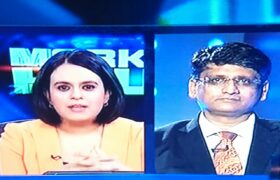India’s growth forecast is the brightest spot in a grim forecast for the world economy.
As Finance Minister Nirmala Sitharaman prepares her budget, the World Bank reports Indias economy grew by 7.2 per cent in 2018-19 in contrast to the recent Indian Central Statistical Office (CSO) estimate of only 6.8 per cent growth during the period.
The Bank’s Economic Prospects Report released on Tuesday forecast India’s economy to grow by 7.5 per cent during this and the next two fiscal years, retaining its top spot as the fastest growing major economy. It would be helped by a “more accommodative monetary policy” and low inflation, it said.
The report retained the forecasts it made in January for India.
India’s growth forecast is the brightest spot in a grim forecast for the world economy. The report said that the global growth rate was estimated at 3 per cent last year and is forecast to dip steeply to 2.6 per cent this year, before edging up to 2.7 per cent next year and 2.8 per cent in 2021.
India “is estimated to have grown 7.2 per cent in fiscal year 2018-19, which ended March 31”, the report said. “A slowdown in government consumption was offset by solid investment, which benefited from public infrastructure spending”.
The Bank said that the cut-off dates for data used in the report was May 23.
On May 31, the CSO said that India’s gross domestic product (GDP) growth during the 2018-19 fiscal stood at 6.8 per cent, lower than the previous year’s 7.2 per cent.
The CSO said the Indian economy grew by only 5.8 per cent in the fourth quarter. That dragged down the fiscal year’s growth rate.
Finance Secretary Subash Garg attributed the slowdown to “temporary factors like stress in non-banking financial company (NBFC) sector affecting consumption finance”.
The World Bank report said, “Growth in India is projected to accelerate to 7.5 percent in FY 2019-20.”
“Private consumption and investment will benefit from strengthening credit growth in an environment of more accommodative monetary policy, and with inflation below the Reserve Bank of India’s target”, it added.
Growth projections for India made by different organisations vary a lot. Last month, UN downgraded India’s growth rate for the current fiscal year to 7 per cent, a cut of 0.6 per cent from the projection made in January and reduced the forecast for the next fiscal year by 0.4 per cent to 7.1 per cent. It estimated last fiscal year’s growth rate to be 7.2 per cent.
In April, the IMF cut India’s growth projections for this year by 0.2 per cent from the 7.5 per cent made in January to 7.3 per cent. It projected next year’s growth at 7.5 per cent, though lower than the earlier 7.7 projection.
The Asian Development Bank said in April that India’s growth rate would be 7.2 per cent this year and 7.3 per cent next year.
China’s economy grew by 6.6 per cent last year and is forecast to grow by 6.2 per cent this year and further decelerate to 6.1 per cent next year and 6 per cent in 2021, the World Bank said.
Pakistan was estimated to have grown by 5.2 per cent last year, but is forecast to steeply decline to 3.4 per cent this year and 2.7 per cent next year, before recovering to 4 per cent in 2021, according to the report.
This despite “financial assistance from Gulf countries and China and an International Monetary Fund programme (that) have helped rebuild confidence”, it said.
Last year, the report said, Bangladesh recorded a growth rate of 7.9 per cent — the highest of all nations, regardless of size, although with a GDP of only about $250 billion, or less than a tenth of India’s, it is not considered a major economy. Bangladesh’s growth is forecast to fall to 7.3 per cent this year, the Bank reported. It is forecast to rise to 7.4 per cent next year and dip to 7.3 per cent in 2021.
Commenting on the global economic outlook, World Bank Group President David Malpass said, “Current economic momentum remains weak, while heightened debt levels and subdued investment growth in developing economies are holding countries back from achieving their potential. It’s urgent that countries make significant structural reforms that improve the business climate and attract investment”.
The Bank report added several notes of caution for India and the South Asia region. “Fiscal deficits continue to exceed official targets in India and Pakistan, and supply bottlenecks and business climate obstacles could hold back investment potential in the region,” it said.
“In addition, non-performing assets in the region remain high. A sharper-than expected deceleration of growth in major economies or an intensification of trade frictions could have spillover effects for the region,” the report added.
It is also an oil importer at risk from vagaries of the oil market.
Brexit also poses another risk to the region, it said: “A number of economies have preferential trade arrangements with the UK, and would be vulnerable to a turbulent UK exit from the European Union.”











